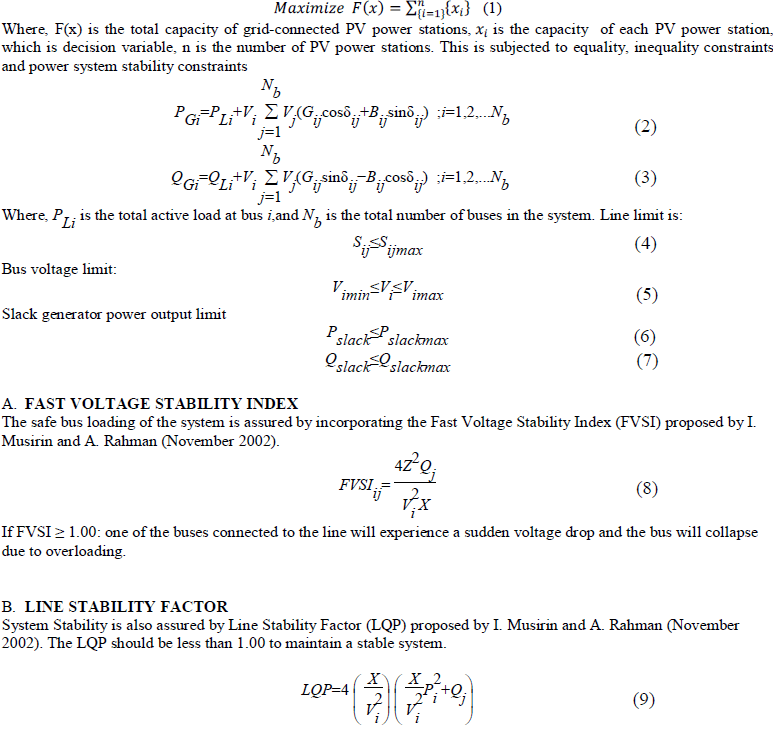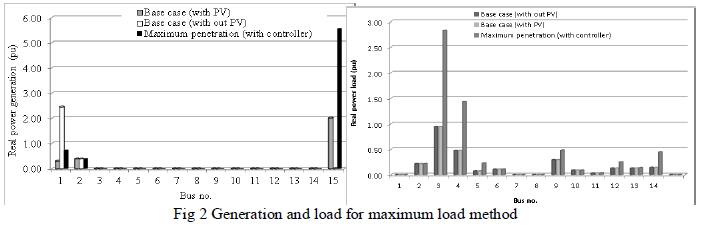ISSN ONLINE(2278-8875) PRINT (2320-3765)
ISSN ONLINE(2278-8875) PRINT (2320-3765)
Chittesh V C1, Elizabeth Rajan2, TibinJoseph3, Sasidharan Sreedharan4, Vipin Das P1, SebinJoseph1, Vishnu J1
|
| Related article at Pubmed, Scholar Google |
Visit for more related articles at International Journal of Advanced Research in Electrical, Electronics and Instrumentation Engineering
Utilization of renewable energy resources (RER's) like photo-voltaic generators, is one of the possible solution for present scenario of energy crisis. Most of the study suggest the implementation of PV power stations at distribution level. In this paper detailed theoretical analyses of the impact of large scale PV on transmission level is analysed. A controller is implemented to find the maximum penetration of solar photo voltaic (SPV) energy. Two methodology i.e. constant load method and maximum loading method is implemented here. A test study is done in IEEE 14 bus to find out the optimal location of SPV Generators and to find the maximum safe instantaneous penetration at transmission and distribution level for both method using particle swarm optimization(PSO). Maximum penetration is achieved by adjusting grid parameters subjected to various power system stability and security constraints. Finally it can be concluded that PSO based optimal control of large scale PV penetration allows us to utilize SPV power efficiently.
Keywords |
| Solar PV,PSO, PSAT, MATLAB, IEEE14 Bus, Optimization |
INTRODUCTION |
| Recently lot of researches are going on in the field of renewable energy resources (RER's). Governments of all nations are prompting implementation and utilization of RER's. This scenario arises to the well-known fact that the increased demand can’t be met by conventional energy resources only. Of all DER's more concern is given to photovoltaic (PV) generators as it is cheaper, easy to set up and can be distributed throughout. On the basis of technology, applications, controllingtechniques, the free running pollution free PV generators has been a worthy topic for power system researchers. Various MPPT techniques used for producing maximum output from solar PV generators (SPVG) has been discussed in T Esram(2007). Interfacing PV system to grid is being analysed in A.Yazdani(2010). In M.Rashed(2008) new control approach for hybrid feeding the power system with PV and conventional generators is discussed. Detailed mathematical and simulation modelling of PV are presented by Tan et al(2010),Xiao et al(2013).Due to efforts from researchers the efficiency of PV has increased dramatically and the price has reduced to affordable limit. In all these literature the SPVG at distribution level is considered. But most of the practical system which are designed for unidirectional power flow will face major stability and security issues when SPVG is at distribution level. So a thorough investigation and study is needed to find the impact of PV penetration on stability and security of power system transmission level. Also other advantages to it are SPV energy can be made dispatchable, they can work as reactive power generators at night etc. Optimally placing and sizing of SPVG in power system would lead to attainment of numerous potential benefits. Hence an algorithm is required to maximize these potential benefits R.Shah et al(2010).Technical concerns with integrating higher penetrations of photovoltaic (PV) systems include grid stability, voltage regulation, power quality (voltage rise, sags, flicker, and frequency fluctuations), and protection and coordination. Also the reactive power support in the transmission system reduces when SPVG at distribution S.Achilles(2008). But by increasing PV penetration the line loss is reduced, voltage profile is improved, power quality is improved, the cost of power reduces, decreases peak power requirements, increases reliability, increases efficiency, and reduces environment impacts A.A.B.rujula (2001). The low voltage ride through capability of PV would help to overlook the negative impact on system reliability. |
MODELLING OF SYSTEM |
| General power injection and current injection modelling is used in modelling of SPV and all other power system devices in PSAT. For each device, a certain set of differential equations and algebraic equations are defined. Complex voltage phasors are split into magnitudes v and phase angles θ. The vector of algebraic variables can be divided into internal device variables, and external ones. Number of state variables is equal to number of differential equations and number of algebraic variables is equal to number of algebraic equations. These set of equations form a consistent DAE system. It is implicitly assumed that the device depends on a set of parameters, which characterize the behaviour of the device itself. By default, parameters are constant. |
PROBLEM FORMULATION |
| Here system with single PV generators is considered. So maximization of output of single generators done which is the objective function. Accordingly the objective function will be:- |
 |
| LQP assure that at no level of bus loading the line is overloaded. |
METHODOLOGY |
| Initially, the Newton-Raphson based conventional powerflow is conducted on IEEE 14 bus system at fundamental frequency to calculate the voltage, real and reactive power flow at base case without controller. |
| Constant load Method:-Constant load method (Generation Displacement method) loads are kept constant but the SPV generations are controlled using controller. PSO finds the optimal location in both IEEE 14 bus system for maximum. |
| Maximum load Method:-Here the load is increased to the maximum using PSO and the SPV generator (SPVG) output is also controlled. The SPVG will contribute maximum to the increased load without violating any security or stability limits. The controller places the SPVG at the optimal location for maximum penetration. Here the load is varied according to |
| Where, m is the total number of generator buses, ïÿýïÿý= 1 indicates the base load case. By varying ïÿýïÿýwe can find the maximum load. |
| PSO:-The particle swarm optimization (PSO) is a population based optimization method inspired by the social behaviour of bird flocking or fish schooling. PSO implements the optimization algorithm and calculate system parameters for maximum penetration. |
TEST SYSTEM AND TOOL |
| IEEE-14 bus test system, which is typically used for low frequency oscillation studies, has been used in this work. Results presented in the paper were produced by MATLAB-based software PSAT F.Milano(2008). PSAT 1.3.4 version was used to develop the PV based generator function file. |
 |
RESULTS AND DISCUSSIONS |
| The SPV is connected to separate bus that is the 15th bus called as SPV bus. This bus is modelled as a ïÿýïÿýΘbus so that maximum load is supplied by SPVG resulting in minimum participation by conventional generators. The SPVG is placed at seven arbitrary positions and the resultant power flow results are analyzed. Different locations of DG gives different power flow results. Most of the literature and previous works suggest that in IEEE 14 bus system the 14th bus is the optimal location in distribution side for SPV. Here the results are given with SPV at 14th bus for comparison. The main work is done with SPV at transmission sector with both methods. Maximum instantaneous penetration depends on various factors like location, load centers, line loading capacity, reactive power demand etc. The load on the buses is kept constant for constant load method. Generation of SPVG is maximized by controlling the voltage and angle of SPV bus. In this work the control variables considered are the slack bus voltage and angle settings to control the load sharing between the SPVG and the conventional generators at buses 1 &2.Using particle swarm optimization algorithm, the optimal location of SPVG for maximum penetration at transmission level was found to be at bus 4. Bus no 1,2 and 3 were not considered as feasible location since they have generators already connected to them. The base case load was 2.66pu, ie 266 MW and this load was kept constant in this method. Initially without SPVG total load was supplied by the generators 1 & 2.when SPVG was connected at 4th bus the 2.02pu of the total generation ie, about 73.18% is shared by it. With PSO this increased to 2.32pu that is about 84.05%of the total generation was done by SPVG at its optimal location.Now with maximum load method the load is increased to the maximum possible value and the contribution of SPVG is in supplying this is found out.The loading of the IEEE 14 bus test system without integration of SPVG can only be increased to 1.2 times the base case loading beyond which the system drives into instability and collapses. With the optimal placement and setting of SPVG the loadability can be increased from the base case loading of 260 MW to 627MW. This is done using PSO. The load is randomly varied and with that the SPVG voltage and angle is controlled to get maximum possible penetration. The optimal location was found to be at 4th bus and SPVG was producing 556MW which is 83.10% of total generation which is equal to 669MW. In all cases voltages at all buses are within the specified limits ie, 1.1 to 0.9. Results of loading and penetration are given in Table 1 and 2. |
 |
 |
CONCLUSIONS |
| In this paper, a new methodology of optimal allocation of SPVG (solar photo voltaic generator) at transmission has been proposed to maximize penetration by taking into consideration the power system stability and security constraints. It is found that PSO based optimization technique is much better to enable optimal allocation of SPVG in powertransmission system. Table 2 gives maximum penetration of solar power in IEEE 14 bus standard test system at transmission level and distribution with two methods. With optimal placement of SPVG near to load center (4th Bus) the most of the load disturbance can be made to be shared by the SPVG. |
 |
 |
References |
|